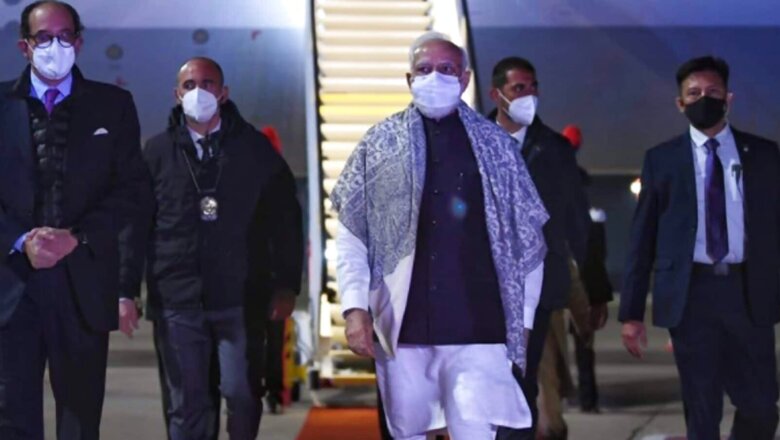
views
Climate change discussions are complex and contentious. While it is the shared interest of humanity to prevent global warming, the inequities at the root of the issue of global warming cannot be easily wished away. The concept of common but differentiated responsibilities as between the developed and developing countries with regard to climate change has been steadily diluted, as has been that of per capita emissions.
This disadvantages developing countries and India, in particular, because of their huge population, low levels of energy consumption and increased energy consumption required for poverty alleviation and economic growth. Nevertheless, India independently of these inequities is aware of its responsibilities with regard to global warming and its consequences for India. On this issue, India faces a multifold challenge to its national interests and its international role. The crux is to find the right balance between national interest and international responsibility.
As in the past, the developed countries seek to push for a solution that is weighted in their favour. They have stronger economies, more financial resources, smaller populations and more advanced technology. Their ability to transition to a green economy is much easier, without compromising their high consumption lifestyles. Over time they have succeeded in shifting the primary burden of responsibility away from themselves to the developing countries increasingly.
The per capita contribution to greenhouse gases (GHG) by countries, which places India in a very favourable position, is no longer a yardstick for measuring responsibility. This is highly invidious for India. If India were 28 separate states, the GHG emissions from the subcontinent would not fall in the category of “big emitters”. India’s size works against it. It is projected today as the third largest emitter of CO2 when its emissions (2.2 giga tonnes) are far below those of China (9.3GT) and the US (4.8GT). On a per capita basis India’s emissions amount to 1.58 tonnes compared US’s 15.5 tonnes, Canada’s 15.32 , Australia’s 15.83, UK’s 5.99, South Korea’s 11.58 and China’s 6.9, Russia’s 10.19, Germany’s 8.93 and Japan’s 8.99 tonnes.
The issue of historical responsibility of industrialised countries for emissions, which is central to the notion of climate justice espoused by India, has been deflected by stressing the shared responsibility today of all countries faced with the catastrophic consequences of climate change, especially the developing ones, considered the most vulnerable.
The principle of Common but Differentiated Responsibility and Respective Capabilities (CBDR-RC) within the 1992 United Nations Framework Convention on Climate Change (UNFCCC) that takes into account the social and economic conditions of individual countries has been steadily eroded in previous COPs, with the Paris Agreement departing from the distinction between industrialised and developing countries by subtly differentiating between subsets of developing countries, such as Least Developed Countries and Small Island Developing States.
ALSO READ | How Indian Policymakers and Citizens Should Read IPCC Report’s Code Red for Humanity
India’s Track Record on the Climate Change Front
Even as pressure on countries like India has mounted, the developed countries have not lived up to their own binding commitments, as for example, under the 1997 Kyoto Protocol and the 2012 Doha Amendment to that Protocol. Canada and the US withdrew from the Kyoto Protocol, while Japan, amongst others, did not take new second round commitments.
The Copenhagen Accord (COP15) of 2009 set a goal of raising $100 billion per year of new and additional financial by 2020 to help developing countries cut carbon emissions (mitigation), along with a new multilateral funding for adaptation. Article 9 of the Paris Agreement endorsed the $100 billion target. Available figures show the UK’s additional finance since 2009 is only $6.1 billion, while that of the US fell by $2.4 billion over the 2009-2018 period. The current target is valid till 2025 after which a new collective target will be fixed from “a floor of USD 100 billion per year.”
Nearly 80 per cent of climate finance to developing countries has taken the form of loans and not grants. In total, rich countries, according to available information, gave just $12.5 billion in the form of grants, $22 billion in loans with better-than-market rates and around $24 billion in loans with standard market rates. Some climate finance experts are concerned that a significant amount of budgeted development assistance has been re-labeled as climate finance. The COVID-19 pandemic has also complicated international climate change cooperation by placing enormous pressure on public budgets.
India under Prime Minister Narendra Modi has been pro-active internally and externally on the climate change front. Rather than India being seen as obstructive, the PM wants to participate in international discussions constructively as a climate change champion, though not at the cost of India’s legitimate interests and compromising its future.
Internally, much of India’s efforts in reducing emissions have come as a result of increased energy efficiency under various programmes. India’s Nationally Determined Contribution (NDC) of increasing the share of non-fossil fuels in its energy profile looks to be on track. In installed capacity of electricity generation, it has already reached 38 per cent against the NDC target of 40 per cent by 2030. India has also announced a target of achieving 175 GW of renewable energy capacity by 2022, which was subsequently enhanced to 450 GW by 2030. Solar power in India is already amongst the cheapest in the world. Tapping into India’s vast solar and wind potential will help replace reliance on coal. India plans to focus on developing hydrogen power.
India’s external partnerships in the climate domain give it credibility to press its case for climate justice and availability of finance and technologies to achieve its declared targets. India is taking leadership in forging global coalitions to boost solar energy through the International Solar Alliance (ISA) launched with France and ramp up adaptation and resilience through the Coalition for Disaster Resilient Infrastructure (CDRI).
In the joint statement issued on the occasion of PM Modi’s visit to the US in September 2021, President Biden expressed support for PM Modi’s intention to achieve a domestic goal of installing 450 GW of renewable power by 2030 and acknowledged the importance of mobilising finance for investments in renewables, storage, and grid infrastructure, which will be done under the US-India Climate and Clean Energy Agenda 2030 Partnership. During Danish PM’s visit to India in October two agreements on research in climate change were signed.
Developed Nations Have to Walk the Talk
India is under pressure to set a date for net zero emissions, as many countries have done, including China (2060). It is being argued that global carbon neutrality by 2050 is the only way to achieve the Paris Agreement target of keeping the planet’s temperature from rising beyond 2°C compared to pre-industrial levels. Theoretically, a country can become carbon-neutral at its current level of emissions, or even by increasing its emissions, if it is able to absorb or remove more. This suits the developed countries because now the burden is shared by everyone, and not only by them.
India is unlikely to announce a target date. It has kept its options open, as can be seen from the joint statement issued after the Quad summit in Washington in September 2021 which talks of achieving global net-zero emissions preferably by 2050, with the caveat “taking into account national circumstances”. India has to assess the feasibility of achieving such a target when its development priorities are yet to be met. The principles of equity and common but differentiated responsibility and respective capabilities have to guide India’s decision.
The developed countries have already appropriated most of the carbon space available to be able to restrict the rise of global temperatures to 2 degrees Celsius. It would be equitable if they reached net zero by 2035 or even net negative zero before 2050—most unlikely—in order to leave much-needed carbon space for countries like India to grow.
ALSO READ | As World Gets Ready for Glasgow, Get Used to Feeling the Earth Move under Your Feet
India’s position is unique. Over the next two to three decades, India’s emissions are likely to grow at a fast pace, as it seeks growth to pull hundreds of millions out of poverty. Afforestation is not a solution to neutralise increased emissions. Most of the carbon removal technologies today are either unreliable or very expensive.
The net-zero goal, besides, does not figure in the 2015 Paris Agreement. India’s view is that instead of opening up a parallel discussion on net-zero targets outside of the Paris Agreement framework, countries should deliver on what they have already promised. The developed nations have never delivered on their past promises and commitments. No major country achieved the emission-cut targets assigned to it under the Kyoto Protocol. The track record on their commitment to provide money and technology to developing countries to help them deal with the impacts of climate change has been poor.
India fears that the 2050 carbon-neutrality promise might meet a similar fate, although some countries are now binding themselves in law. It believes that the developed countries should, instead, take more ambitious climate actions now, to compensate for the unfulfilled earlier promises. India is the only G-20 country whose climate actions are compliant to the Paris Agreement goal of keeping global temperatures from rising beyond 2°C.
Some of India’s positions, views and concerns seem to have been incorporated in the G20 Rome Declaration, such as CBDR-RC, critical enablers for galvanising global climate action which includes commensurate, long-term, concessional climate finance, access to affordable and sustainable technology, and commitment to adopt sustainable lifestyles, responsible consumption and production patterns and importance of meeting SDG-12 targets, especially by the developed countries.
The absence of China’s Xi Jinping and Russia’s Vladimir Putin at this week’s COP26 summit indicates how a global agenda is being affected by rising tensions between them and the West. Normally such conferences provide an occasion for heads of countries to have forward-looking bilateral dialogues, but that spirit of dialogue is absent today in ties between the West and China and Russia respectively.
The author is Former Foreign Secretary. He was India’s Ambassador to Turkey, Egypt, France and Russia. The views expressed in this article are those of the author and do not represent the stand of this publication.
Read all the Latest News , Breaking News and IPL 2022 Live Updates here.




















Comments
0 comment